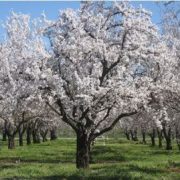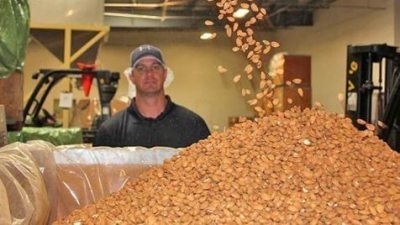Yes, that?s right, you read it correctly, almonds.
By now, many of you have figured out that I like calling my paid subscribers to find out how they find the service. I always ask for suggestion for improvements. Then I ask what they do besides trade the markets.
I get an amazing array of answers. One reader flew helicopters in Alaska to inspect oil pipelines, executing trades on his cell phone in between flights. Another ran a Russian hedge fund in Moscow.
The sheep farmer in Australia relied on me as his connection with the rest of the world. The family office in Spain valued my American view of the world.
Then I called Brad in Modesto, California, who said he was in the Almond business. My interest piqued, I proceeded to grill him. And with that, I obtained a fascinating insight into an obscure corner of the global economy.
If you thought marijuana, estimated by the DEA at $6 billion a year, was California?s largest cash crop, you?d be wrong. Grapes used to be our largest legal crop, at $5 billion a year. But almonds will beat all this year, possibly reaching as high at $8 billion.
You can blame the California drought, now in its fourth year. It has only rained once in the Golden State so far in 2015. This has driven the price of almonds from $1/pound a few years ago to as much as $4/pound today.
The price spike has ignited fierce water wars across the state, with increasingly desperate farmers battling over an ever-diminishing commodity. Those located in the eastern half of the Central Valley (which you will remember from your freshman English class in The Grapes of Wrath) are sitting pretty.
They have long term contracts to buy water from federal public works projects at subsidized prices that date back to the Great Depression. These rights can make or break the value of a farm, and are passed down from one generation to the next.
The Western half of the valley is another story. When construction of Interstate 5 was completed in 1979, most of it was still barren desert, a rain shadow effect of the state?s coastal mountain range.
Only the oil industry was there in force, especially around the Elk Hills oil find (watch the Daniel Day Lewis movie, There Will Be Blood). I know because my grandfather worked there for Standard Oil during the 1920?s.
So when large scale farming developed there during the eighties, they had to buy water on the spot market. The problem is that during a draught, there is very little water for sale. So parched farmers have turned to drilling to irrigate their fields.
This has lead to an even bigger headache. In the 19th century, you could drill 100 feet and find all the water you wanted. Today, they have to go as deep as 1,200 feet, and even these ancient deep aquifers are drying up. And that?s assuming you have the $1 million it costs to drill such a well.
Indeed, the elevation of the Central Valley has fallen by ten feet over the past century because of the underground water that has been withdrawn so far. Destruction of rural buildings through catastrophic subsidence is becoming widespread.
The only alternative is to let your crops die. You see this in abundance while making the drive from San Francisco to Las Angeles, withered trees frozen in tortured, grotesque death throes. Also plentiful are irate billboards attacking the government for depriving local farmers of their cheap water.
Even if you have plenty of water, it is still not smooth sailing in the almond business these days. China is the world?s largest buyer of almonds. The demand there has been so great that the Chinese have become major buyers of almond farms throughout the state, at premium prices.
However, the Middle Kingdom?s recent anti corruption campaign is starting to take a big bite out of sales.
In years past, individuals would buy dozens of boxes of almond cookies to pass out to friends, customers, employers, government officials and regulators during the Lunar New Year celebrations. Not so today. The difference has lead to the cancellation of a few shiploads of the prized nuts.
Brad kindly invited me to tour his roasting and packaging facilities the next time I was in the neighborhood.
I was left thinking, this really is a global economy that is so integrated that, when a butterfly flaps its wings in Brazil, it causes a typhoon in Japan. It is also a great example of how information about one asset class can provide insights about all the others.
With that, I opened a fresh can of Blue Diamond almonds that I picked up at Costco and grabbed a handful.




